Communicating Christ in a Multicultural World
12. Minor Indian Religions
Lesson Objectives
To understand three key minor religions that originated in India, and how to reach their adherents with the Gospel of Jesus Christ.
Introduction
1. SIKHISM
Who are those men with turbans and beards? They are all called "Singh". What links do they have with militants and terrorists seeking independence for the Punjab? Are they related to Islam? Hinduism? Are they dangerous? Are they open to the Gospel?
Sikhism is one of the "recent" religions of India. Its believers call themselves Sikhs, or "disciples". They follow the teachings of 10 "gurus" (in Hinduism, spiritual teachers who are guides to those who seek the truth; whose presence provides instruction; and whose direction is necessary for spiritual progress). The Sikh "Guru Granth Sahib" (Revered Book of the Lord), or Adi Granth (First Book), includes the teachings of the first five gurus, the ninth guru and other non-Sikh "holy men". About 16 million Sikhs live in India, the majority in the northern state of Punjab (lit. "land of five rivers"). Communities of Sikhs also live in the United Kingdom, the USA, Canada, Malaysia, Singapore, Australia and East Africa.
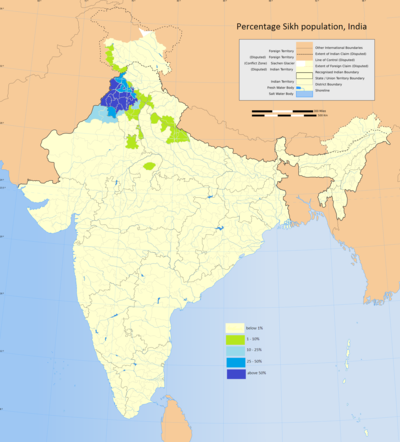
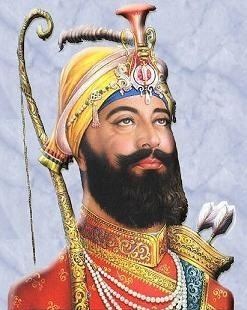
Development
The first Sikh guru, Nanak, was born into a Hindu family in 1469 (died 1539) and came into contact with Muslims in his early life. When he was 30, had "vision of God", who gave him nectar to drink, told him he was blessed, and instructed him to teach others to rejoice in God's name and seek union with Him. He preached that there is one God, the invisible, omnipresent creator. "God" does not have physical attributes, is beyond human comprehension, has never been incarnated on earth (like the Hindu avatars, lit "one who descends"). Nanak criticized Hindu & Muslim religious practices with emphasis on outer forms of prayer and ritual; he emphasized inner spiritual awakening. Also challenged the Hindu caste system. Taught that while rituals are unnecessary, right conduct is essential. He instructed his followers to be aware of God's presence by rising early, bathing, meditating on the divine name, and directing each day's activities to Him. By doing so, and by living a good and simple life, people could be free from the cycle of reincarnation. Had much in common with the North Indian mystics, who sought union with God through devotion and love.
He also developed the militarily until they became a distinct community. (Punjabi identity today centres on Sikh ideas. Community and religion go hand in hand. Rejected inequalities created by the caste system, and orthodox Hindu priesthoods such as the Brahmins.)
According to Sikh belief, God is the true Guru He has created the world, which enables man to understand something of his power and will. His grace enables sincere devotees to experience him through worship and meditation. His divine and creative word (shabad) came to man through the historic "gurus".
| Nanak | 1469-1539 | Most Sikh doctrines were developed during the period of the first five "gurus" |
| Angag | 1504-1552 |
| Amar Das | 1479-1574 |
| Ram Das | 1534-1581 |
| Arjan Dev | 1563-1606 |
| Har Govind | 1595-1644 | |
| Har Rai | 1630-1661 |
| Har Krishan | 1656-1664 |
| Tegh Bahadur | 1621-1675 |
| Gobind Singh | 1666-1708 |
Each of these men was said to have possessed the same truth, the same insight into God and shared the same basic identity. Sikhs consider them to have been like "candles".
The Sikh community is the current Guru. The Granth Sahib is also considered a Guru.
In 1526, Muslims from what is now at Uhanistan conquered northern India (founded the Mughal Empire.) Arjan, the fifth Guru, built the Hari Mandir, the Golden Temple at Amritsar, which became the centre of Sikh religious and national life. He was subsequently killed in 1606, while in Muslim custody, and is considered a martyr. Became rallying point for Sikh nationalism.
By the time of Gobind Singh, Sikhs had to defend themselves from Muslim persecution. In 1699, Gobind Singh organized his followers into a military order called the Khalsa (Pure). Sikh men and women were initiated by sharing a drink of sweetened water called amrit (nectar), a symbol of loyalty to the guru and hope for a higher spiritual existence. Men took the name Singh (lion) and women the name Kaur (princess). The ideal of the true Sikh became the "saint-soldier" of the Khalsa who combines the virtues taught by Nanak and Gobind Singh

Before Singh died, he indicated that the holy book, the Guru Granth Sahib, was to become his successor. Consequently, the Guru Granth Sahib is revered by Sikhs and readings from it form a central part of acts of worship in the gurdwara (lit. temple or home of the guru).
In the early 1800s, Sikh ruler Ranjit Singh established a Sikh kingdom in Northern India. In 1849, he was conquered by British. When India/Pakistan became independent nations in 1947, almost half the Sikhs lived in Pakistan > many emigrated to India.
By the 1960s, the Sikh community was playing a leading role in India's agriculture, business and professional work, and military life. In 1966, India made the state of Punjab smaller, leaving the Sikhs in the majority. Anandpur, where the Khalsa was founded, and the holy city of Amritsar lies in the Punjab
Sikhs demanded more control of Punjab. In 1984, Sikh militants occupied the Golden Temple and the surrounding sacred buildings in Amritsar. Indian army action to remove them caused great damage and many deaths. The government set up military rule in the Punjab, and some radical Sikh groups continued their rebellion
The 20th century has seen a rapid spread of Sikhs outside of the Punjab. The Sikh Missionary Society (seeking commitment from Punjabis; it is an ethnic religion that strives to maintain the community) and similar movements operate around the world
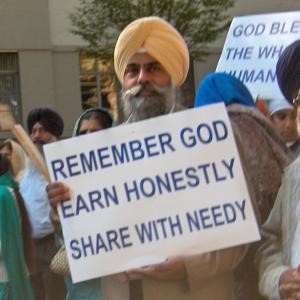
Patterns of Worship
Sikhs believe in reincarnation. In karma, a person's actions determine whether the soul will enter the next life as a plant, animal, or human being. Only someone who reaches a higher state of spiritual development by conquering the idea of separateness from God, ceasing to be worldly-minded, and becoming aware of the inner presence of God, can be free from experiencing further earthly lives.
Sikhs believe that, as people become aware of God, they are prompted to see their own lives in different ways. The individual seeker realises he is tangled up in pride, ignorance, worldly passion and materialism. The only hope for sinful man is that God is merciful. He will grant to the true seeker a sense of His presence. As the individual dwells on the name of God, by repeating sacred verses, God will embrace him and give him an awareness of His nature. The way of salvation is therefore by regarding God, not self, as the centre. Devout Sikhs read or listen to hymns from the Guru Granth Sahib and other scriptures at home or at the gurdwara (lit. "the Guru's door", ie the place where the book is located) every morning and evening. The Guru Granth Sahib has acquired great status- Sikhs down before it and choose their babies' names from random readings. They do not have a weekly holy day. A gurdwara may be ornate or plain and include a hostel and place for serving meals to the community and guests. Sikhism forbids representation of God in pictures and the worship of idols. There should be no distinction between social class or caste in the gurdwara and Sikhism has no priesthood or ordained ministry. In fact, many gurdwaras pay a salary to a granthi to carry out such activities as reading from the scriptures and performing marriage ceremonies, on a full-time basis.
Music plays an important part in worship at the gurdwara, where musicians sing hymns accompanied by a drum, a harmonium, and other instruments.
Sikhs are expected rise before dawn, bathe and recite prayers. Sikh baptism is performed in front of the Adi Granth. The Adi Granth is also used in marriages, with the couple going round it four times to the recitation of hymns.
The Sikh religion forbids alcohol, tobacco, and other drugs.
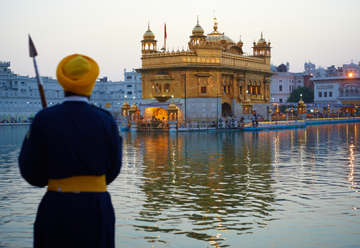
Like most religions, there are several sects and orders within Sikhism, based largely on disputes about succession or ritual/tradition.
Sikhs believe they have their own identity. Arjan wrote:
"I do not keep the Hindu fast, not the Muslim Ramadan.
I serve Him alone who is my refuge.
I serve the one Master, who is also Allah.
I have broken with the Hindu and the Muslim.
I will not worship with the Hindu, nor like the Muslim go to Mecca.
I shall serve Him and no other.
I will not pray to idols, nor heed the Muslim 's call.
I shall put my heart at the feet of that one Supreme being.
For we are neither Hindus nor Muslims
This fierce separation is indicative of the strength of religious identity in India.

Traditional Practices- Five "k"s
| kesh - | uncut hair; men wear a distinctive turban, to keep their long hair clean and tidy, and as a symbol of Sikh identity |
| kangha - | comb, used to keep the hair clean |
| kara - | metal bangle |
| kaccha - | special knee length underwear |
| kirpan - | dagger |
The Sikh religion offers:
- identity (albeit sometimes militant);
- equality and brotherhood (eg common eating facilities remove caste barriers;
- help for the underprivileged); in reality, however, Sikhism still possess internal divisions of caste;
- help with arranged marriages; in some places, people meet in different gurdwaras depending on caste;
- greater congregational involvement that any other religion in India;
- moral uprightness;
- hope for future release from endless reincarnations.
2. JAINISM
Almost all Jains live in India, where they are the sixth largest religious community. This religion has had a major influence in the lives of "peace" activists such as Mahatma Ghandi and those who followed him, because of its emphasis on "ahisma", or nonviolence toward living things.
There are more than three million Indian Jains. As a wealthy religious community, Jains have had a powerful influence on the life and history of the Indian subcontinent. There are also communities of Jains in East Africa (mainly Kenya), Europe (mainly England), and the United States and Canada. Very small numbers in Australia.
The Jain religion takes name from the fina (lit. victor or conqueror), title given to 24 teachers called Tirthankaras (lit. "ford-makers?', because they helped others cross stream of existence to liberation). Demonstrated and taught a Jain "path of purity" (domination of emotions and passions) and peace that leads to spiritual liberation. Little is known about the first 22 teachers. The last two, Parsva (about 877-777 BC) and Mahavira (about 599-527 BC), lived and taught in north-eastern India. Gained considerable followings. Huge statues to the Tirthankaras are to be found in Southern India.
Mahavira ("Great Hero" - born 540 BC), the last of these teachers, lived at the same time as Buddha. Like Buddha (whom he opposed), he rejected the Hindu caste system and rituals of sacrifice. (At the time, India was in the midst of social, political and intellectual ferment. Tribal society was disintegrating and kingdoms were emerging.) Mahavira started as a warrior prince. At 28, on the death of his parents, he left home, renounced his family and became a beggar and ascetic. He plucked out his hair, discarded his clothes, and wandered (mostly naked) for 12 years, fasting and practicing penance in search for truth and liberation from an endless round of birth/death/reincarnation. Around 40 years of age he attained what his followers claim was enlightenment (a state of divine knowledge, or kevala; becoming a perfect soul, or kevalin). He believed this set him free from the forces of karma that bound him to the wheel of rebirth. For the next 30 years he travelled across northern India, teaching an austerely ascetic path to purity and peace. The Kalpa Sultra, a Jain book that records the lives of the teachers, records that he died at Pava (modern Bihar) at the age of 72 (his cause of death was voluntary starvation), and entered nirvana. He left more than 500,000 followers, including 50,000 monks and nuns (many from the aristocracy).
Sects and teaching
Two major sects, or groups, developed within Jainism after death of Mahavira. The Digambara (space-clad, or naked) and the Svetambara (white-clad) split about 360 B C A severe famine in the Ganga Valley caused one group of Jain ascetics to migrate south to the Deccan. When these naked southern Jains returned north to Bihar, the northern monks had begun to wear a piece of cloth. A dispute followed, in connect with clothing and differences over the canon, the division was fixed by A.D 79 or 82. Today most Jains in southern India follow the Digambara sects, while most in the north follow Svetambara sects.
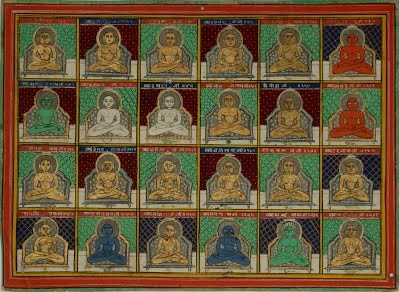
Jains believe all human beings, animals, insects, plants and even earth, stones, fire, water, and air have living souls (jiva). They also believe that the soul in its pure state is omniscient (all-knowing). Through contact with matter (ajiva, or non-souls) in this world, the soul becomes polluted and weighed down, meaning it will have to go through further rebirths. Jains think of karma as fine "atomic particles" which cling to the soul. Deeds of violence, greed, selfishness, dishonesty, sexual misconduct, and covetousness (attachment to the things of this life, such as food, clothing, lodging, women and jewels), false belief obscure the soul. Acts of gentleness and penance lighten and liberate it.
Only the liberated soul understands the nature of life and the transmigration of the soul from one level of consciousness to the other (up or down the scale, depending on karma).
- at the lowest level are souls possessing only one sense touch; these include the elements: water, earth, air, fire and the vegetable kingdom;
- second level - touch and taste; including worms and shell creatures;
- third level - touch, taste and smell; including ants, bugs and moths;
- fourth level - touch, taste, smell and sight; wasps, locusts, butterflies;
- fifth - touch, taste, smell, sight and hearing; higher animals, humans, heavenly beings.
Jains believe birth as humans occurs rarely, so man should use every opportunity to pursue the way of salvation by acquiring the "three Jewels", right knowledge (through the Jain Creed); right faith and right conduct
Monks and nuns represent the ideal of Jainism. Monks own no property except a broom, simple robes, bowls for food, and walking sticks. They may not live in buildings except for brief periods, and they must beg for all their food. They perform severe penance to "burn out" the karmic matter weighing down the soul. They believe this lightens and frees the soul, so that it can rise to a state of perfect peace and purity. At the heart of Right Conduct for all Jains lie five vows. These are ahimsa, non-violence or non-injury; satya, speaking the truth, asteya, not taking anything which has not been given; brahmacharya, chastity; and aparigraha, non-possession or detachment from people, places, and things.
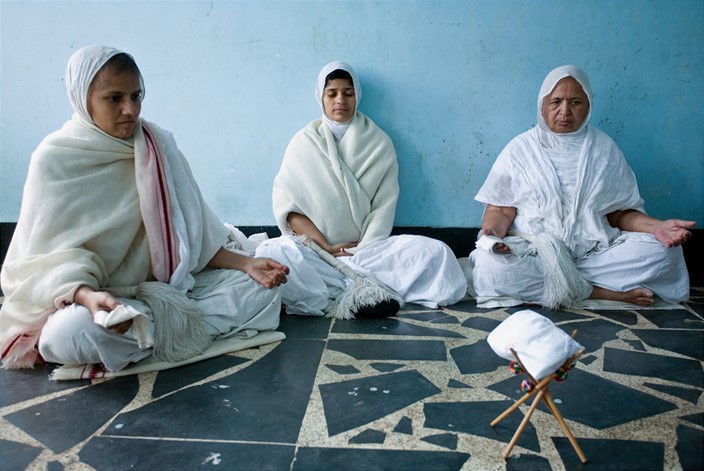
Other members of the Jain community are the laity (people who are not monks or nuns). They assist the monks and nuns to live out their vows perfectly. Lay Jains can undertake business and other activities, while attempting to fulfil their religious vows as best they can. Religious vows include.
- truthfulness;
- non-stealing;
- chastity;
- non-attachment to possessions or worldly goods;
- restricted travel (to limit temptation and sin);
- discouraging lying, stealing, etc.;
- discouragement of carelessness in speaking of others;
- spending 48 minutes a day meditating, thinking no evil, being at peace with the world, contemplating spiritual heights;
- setting aside a particular day to be more serious about meditation;
- living as a monk for temporary periods (fasting, remaining celibate, wearing only restricted clothing);
- supporting the ascetic community.
Those who want to progress further take the following vows:
- worship the deva, ie reverence a true guru;
- avoid gambling, eating meat, wine, adultery, hunting, stealing;
- engage in meditation at least 3 times a day;
- live the life of a monk for at least six times a month;
- avoid uncooked vegetables;
- refrain from eating from sunset to sunrise and take care eating during daylight hours (in case an insect is imbibed);
- keep away from one's wife and not seduce her by scents;
- never start things of world pursuit that might lead to destruction of life;
- eat only left-over food;
- wear dress of an ascetic.
Jains then seek to become "gentlemen" (a further 21 vows).
Ascetics must take vows of non-violence; truthfulness; non-stealing; total chastity; renouncing love for anything or anyone. (people, colours, sounds, smells).
Jains in the community.
Jains vow not to kill any living creature (to kill with deliberate intent has grace karmatic results). Monks and nuns carry brooms to sweep all surfaces to avoid crushing insects accidentally. The vow of ahimsa, or non-violence, has always been important to Jains. They keep to a vegetarian diet, and only do work which avoids any form of killing (however, they do not engage in agriculture, for in ploughing they might accidentally kill a worm or a plant.
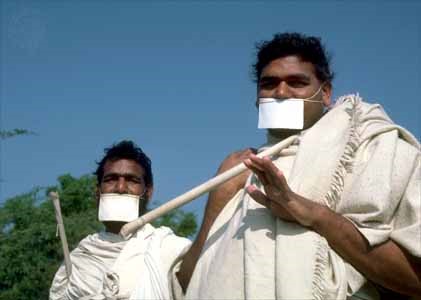
Ahimsa requires positive acts of kindness, compassion, and charity. Jains are not permitted to employ certain crafts, eg metal working, as the metal would suffer pain as it is worked. In India Jains use their wealth to set up and run hospitals and clinics for both humans and animals- They also establish schools and colleges, resthouses, and almshouses for people of all castes and creeds-
Wealthy Jains have made major contributions to education and the arts in India. Jain temples are among some of the most beautiful. These temples are often the focus of pilgrimages, particularly in the states of Rajasthan, Gujarat, Maharashtra, Madhya Pradesh, and Karnataka in western India.
Festivals. The greatest Jain festival, Paryusana, takes place over an 8-10 day period about the end of August or the beginning of September. It is a time of fasting, repentance, and universal goodwill. On the last day, Samvatsari, Jains visit friends and relatives, to seek forgiveness for any harm or injury committed during the previous year. The other important modern festival for Jains is Mahavira Jayanti, which falls in March or April and is marked by meetings and processions celebrating Mahavira's birthday.
Fasting until death. Jains have an unusual attitude to death. A devout Jain who feels ready for death takes the vow of sallekhana. Supervised by monks and nuns, he or she meets death through a controlled process of fasting.
Jains are fatalistic and deterministic; they are pessimistic (the world is a place of misery and sorrow), frequently pray to Hindu gods for help and follow Hindu customs; are bound by endless (but futile) works to obtain salvation.
3. PARSEEISM
Parsees (from "Persia", from which they fled seeking religious freedom in 9ff C AD to escape persecution by Muslims) are members of the Zoroastrian community located mainly in the area of Bombay, India. They have lived securely under Hinduism, although they were persecuted during Muslim invasions in 1400s. Obtained freedom of religion under British, who established Bombay (now Mumbai) as a commercial base. This led to substantial wealth. Amongst most highly educated Indians in Bombay - English education led to political influence.
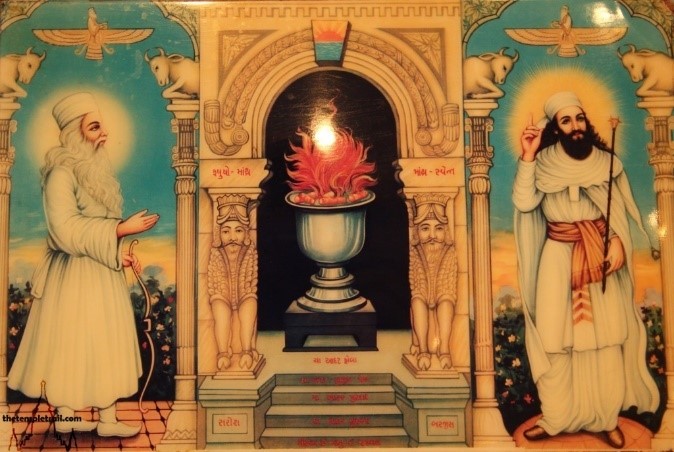
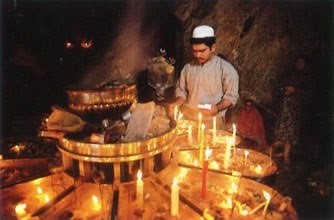
Parsees believe in the god Ahura Mazda and worship in "fire temples". A sacred fire burns continuously in the temples to symbolize Ahura Mazda, approached only after ritual cleansing. Stress the importance of holiness. No artificial lights (these would dull God's creation). Temples are closed to nonbelievers. No special day is set aside for worship, but religious activity becomes festive at the New Year and on the birthday of the prophet Zoroaster.
Parsees follow a sacred book called the Avesta, which teaches good thoughts, good words, and good deeds.
Major events in Parsee lives are.
- initiation: around 9 years of age, "join God's army"; involves donning a sacred white (purity) shirt that is henceforth worn under all clothing, and a woolen cord that is tied/untied 5 times daily in worship to God;
- death ceremonies: Zoroastrians regard death as only a temporary victory of evil, a place where demons are present. The purpose of Parsee funeral rites is to remove that evil. The corpse is washed and clothed in clean but old clothes. After prayer, mourners carry the body to a tower called dahhmqa (tower of silence), that is open to the sky. There the corpse is stripped so that vultures can devour it. Relatives wait till this is finished (c. 30 minutes), then return home for 3 days of prayer pending the judgement of the soul of the departed. The bones are cast into a pit. This rite is carried out because Parsees believe earth and water are sacred creations of God; fire is sacred. They believe that God created vultures for this purpose.
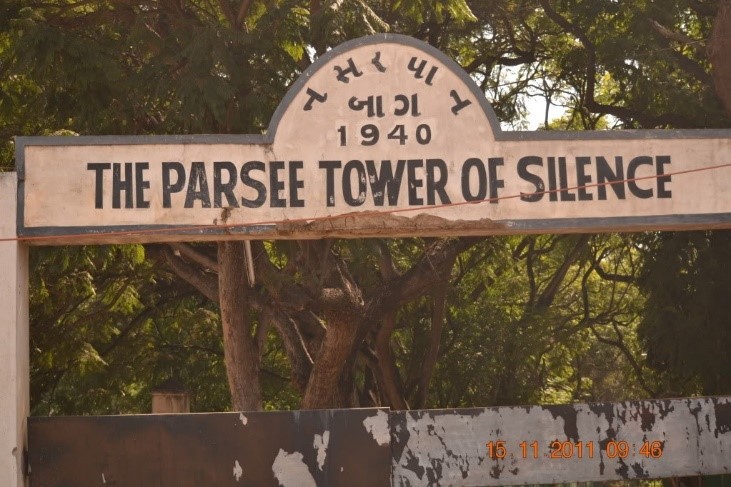
In spite of their relatively small numbers and concentration (70% live in Bombay), Parsee Zoroastrians have gained a reputation for their leadership in education and have earned distinction in economics/commerce, industry, the arts, and politics (especially in the Congress Party).
Charity plays an important role in the community.
Reaching Sikhs, Jains and Parsees with the Gospel
These communities are easy to dismiss because of small numbers compared to Muslims and Hindus, but they still need salvation. A big key to reaching them is through family and friends who come to Christ.
Need to teach:
- the vicarious death of Christ - no karma or need for reincarnations;
- the future of the soul & judgement/reward (cf Hebrews 9:27);
- the uselessness of works cf effectiveness of faith in Christ;
- assurance and hope of salvation;
- personal relationship with God
- inclusive, unconditional, open family of God
- power of the Holy Spirit to set us free from sin and transform our hearts.
We also need to live holy lives characterised by the presence and joy of Christ, to provide a contrast of "life" against the backgrounds of their severe legalisms.
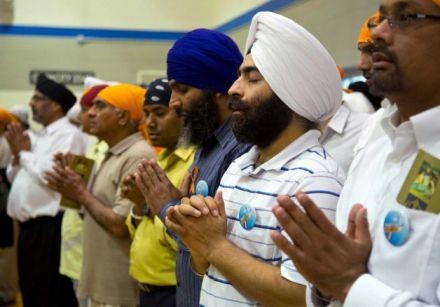
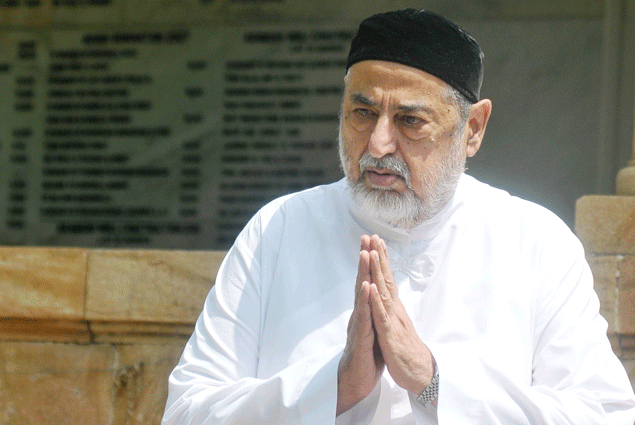
As Zoroastrians Enter a New Era, Assimilation Becomes a Concern
January I, 2001
By GUSTAV NIEBUHR
HOUSTON, Dec. 29 T
The cities listed on name tags worn by men and women at a hotel here offer evidence that a highly international gathering is taking place. People have come from Toronto, Los Angeles, London, Bombay and Tehran, Iran. Yet they share a common bond as Zoroastrians, members of a monotheistic faith whose long history includes centuries of glory as the religion of classical-era Iran.
The geographic diversity at the Seventh World Zoroastrian Congress indicates a new chapter in an ancient faith, a process of globalization that carries opportunity and peril.
Among Zoroastrians, a "second diaspora" is under way, said Jamsheed Marker, a veteran Pakistani diplomat who is an under Secretar-General of the United Nations. About 11 centuries ago, many made a migration, "a flight from oppression, he called it, from Iran to India. Behind today's journeys, he said, lies "an incentive to become part of the future and participate in it".
If the future for Zoroastrians is measured by professional achievement, then it is on display here at the conference, at the J. W. Marriott Hotel in Houston's upscale Galleria district. It is the first time such a gathering has been held outside Asia. The program for the five-day event, which runs through Monday, is thick with advertisements placed by Zoroastrian business people, real estate agents and engineers.
"I think you will find for the most part, our community is very well-educated, very literate, especially those in North America", said Mazda Antia, 26, a Zoroastrian priest and recent law school graduate who works as a law clerk for a federal judge in Fort Lauderdale, Florida.
But amid the plenty, there is some unease, as many Zoroastrians worry that as they become increasingly scattered, they risk assimilation into the cultures around them.
"We're not living in proximity, in the neighbourhoods we had in India, said Sarosh J. H. Manekshaw, president of an environmental consulting firm in Houston. "We are free to travel all over the world."
The change has fuelled a debate over whether the faith should accept converts, something prohibited by Zoroastrians in Bombay, long the centre of the faith's influence. AS Mr. Manekshaw said, "It is a very polarizing issue."
Contributing to the anxiety is an increase in interfaith marriages involving Zoroastrians, a trend that some worry will leave the children of those unions with little connection to Zoroastrian traditions. The situation echoes similar concerns among American Jews, who also struggle with questions related to a high rate of interfaith marriage.
But American Jews, with a population of six million, have the advantage of numbers. There are only about 200,000 Zoroastrians worldwide, with 18,000 in North America and several hundred in Houston.
The religion they follow was expounded by the prophet Zarathustra, about three millenniums ago in Persia, as Iran was then known. He taught an ethical code, urging believers (who are also known as Zarathushtis) toward good thoughts, good words and good deeds. The faith proclaims belief in a single deity, Ahura Mazda, whose name means Wise Lord. A central tenet is that human beings have free will, to think for themselves and choose between good and evil. The ultimate goal is to do good, eliminate evil and move the world toward perfection.
Zoroastrianism long held a dominant position in ancient Iran, but it suffered two cataclysmic shocks. The first came 2, 300 years ago, when the Macedonian warrior Alexander (whom history calls the Great, but many Zoroastrians call the Accursed) trounced Persia s armies and torched its palaces and libraries. The second came in the seventh century, when Islamic armies conquered the region.
Zoroastrians who did not convert to Islam became increasingly oppressed. Some left, settling around Bombay and becoming known as Parsis. They agreed at that time that they would not accept converts.
These days, some wonder whether that rule has outlived its usefulness.
"I argue that by theological principles, the acceptance of non-Zoroastrians into the community is permissible, t' said Farhang Mehr, professor emeritus of international relations at Boston University, who said Zoroastrians in his native Iran decided in favor of that course some years ago. If the religion is good, then others will benefit from it, he said.
Dina G. McIntyre, an Indian-born corporate counsel, said she regarded the debate as a question of what was right. "And the right thing to do is to give people a choice, so if they want to live their lives in accordance with a certain teaching, they can, she said. "That was the essence of Zarathustra's teaching.
But Jal N. Birdy, a structural engineer who leads the North American Mobeds Council, which represents Zoroastrian priests, took a different view. "In order to survive in a vast multitude of different races and cultures, we had to formulate certain rules, he said. "And one of the rules is, we have to be an exclusive community, which is borne out by our scriptures. We have to encourage people to marry within" the faith, Mr. Birdy said.
Zoroastrians, he said, respect the world's major religions as offering different paths to God. "To forsake one's religion and come into another, is to our minds an insult to that religion", Mr. Bird said.
The weight of history hangs in the debate. In the first diaspora, some groups of Zoroastrians went to China, Russia and Europe. But they later vanished, absorbed into the surrounding cultures.
Nonetheless, that aspect of the past may not necessarily be the prelude to the future, especially because today's Zoroastrians have air travel and the Internet to keep in touch.
As they have left India and Iran to settle elsewhere, Zoroastrians have created new institutions. Immigrants to the United States now have 24 local Zoroastrian associations, as well as a national organization, which publishes a magazine, the Fezana Journal. It includes space for men and women to advertise for Zoroastrian partners.
Perhaps more to the point, in the magazine's current issue, John R. Hinnells, a British professor of comparative religions, wrote that in most places he had surveyed, from Sydney to Houston, London to Hong Kong, there are more religious functions in the 1990s than there were in the 1960s, partly because there are more centres and partly because there are more Zarathushtis.
That, he wrote, ran contrary to the generally held opinion of the 1960s and 70s that migrants would assimilate and merge into the wider society.













